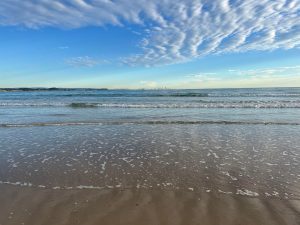Mining and the Coast
Coastal landscapes in many parts of the world have been transformed, or in other ways impacted, by mining. This includes oil and gas extraction. Any visit to Cornwall will provide a visual reminder of tin mining from ages past. Societies and economies have and will continue to exploit mineral resources. An understanding of the impacts on coastal environments is critical in efforts to mitigate adverse immediate and long-term effects.
Mining can stir emotions. There are those who passionately seek to restrain or stop mineral development in direct opposition to local and broader commercial desires to benefit from such activities. It can get nasty leading to demonstrations, threats and legal conflict. Here I will briefly touch on events and debates that have resonated with me in Australia and overseas. There are some where I can only express great sadness at impacts, but there are others where I have been either an observer or a participant in mining.
There is an air of inevitability over oil spills. Offshore drilling and transport accidents have created local and regional disasters. Whether it be Exxon Valdez in Alaska in 1989, the BP accident in Gulf of Mexico in 2010, or the horrendous Torrey Canyon tragedy off the southwest English coast in 1967, they all create visions of death and suffering of wildlife that stays with one forever. More recently sabotage of pipelines in Nigerian coastal wetlands shows how far some will go to disrupt oil supply. Most nations have oil spill contingency plans in place. In Australia controversy surrounds oil exploration whether it be off the west coast at Ningaloo, or along the Great Barrier Reef the subject of “Save the Reef” campaigns of 60s and 70s. I wrote about this in a blog on the famous poet and environmental advocate, Judith Wright, the author of Coral Battleground (No. 182, January,2021). And who can forget the furor just before the 2022 federal election when the former Prime Minister took steps to overturn oil exploration licenses off the NSW central coast; yet here the threat remains, and local communities are alert with concerns.
Another devastating impact involves hydraulic mining with sluicing for gold and other minerals into rivers that flow to the coast. The gold rush in California in the 1840-50s generated mass transport of sediment into coastal bays. This occurred to a lesser degree in Australia such as along the Deua River and Araluen Creek adversely impacting on shipping with the spread of sand banks in the vicinity of Moruya. On a huge scale between 1972 and 1989 Bougainville Copper Ltd pumped tailings from its copper concentration and flotation works at Panguna down the Jaba River to Empress Augusta Bay (discussed in Blog No. 77, April 2017). Visiting the area in the 1970s to advise on mangrove stabilisation of the delta formed by these sediments proved fruitless as the delta later subsided through earthquake liquefaction. Local communities were distressed by much of the devastation due to mining. It ceased in 1989 following militant activity leaving the lands and rivers greatly scarred.
For three years we lived in a mining town in northern Quebec called Schefferville (1967-1970). McGill University had a small research station which offered a range of opportunities to undertake research in fields other than coastal. It was a chance to become familiar with mining activities from exploration, geotechnical stability, permafrost monitoring, operations and processing. Iron ore was transported to the port of Sept-Iles on the Bay of St Lawrence. It was here I had a chance to investigate shoreline changes in advance of the company building a pelletising plant behind a dynamic beach (see Blog No. 80, May 2017). There were also issues of slope instability in uplifted Holocene marine deposits in the valley that was traversed by the railway that brought the ore to the sea. I supervised a student, Lynda Dredge, on this “gully flow” project, and we published in the Canadian Journal of Earth Science (1976, v.13).
I have had some exposure to other mining activities in Australia that remain of concern from both past and present operations. In all cases there are implications and concerns from First Nations peoples which are slowly but often painfully being addressed. There are those in the industrial coastal districts of the Pilbara where precious interests of indigenous groups are at risk. Uranium mining in Kakadu impacting on the Alligator river systems has generated considerable debate and remedial actions over the years. Lake Macleod in WA should long ago have been declared a site of national significance with its karstic inland mangrove community. However, it has salt mining activities that appear to conflict with any protection decision.
Around sections of the Australian coast certain combination of minerals have long attracted commercial and environmental conflict. Sand deposits of Tertiary and Quaternary age can contain “heavy minerals”, in particular rutile, zircon and ilmenite, in ancient beach and dune deposits. In places there are seams containing gold and a radioactive mineral, monazite. Since the early 1960s I have had a fascination with both the scientific and environmental significance of heavy minerals. I have touched on both aspects in a previous blog related to Fraser Island, now known as K’gari (No. 137, May 2019). The next two blogs will give me an opportunity to discuss (1) aspects of the science behind heavy mineral sand deposits; and (2) some of the controversies and policy issues that have arisen in the past, especially on the east coast.
Bruce Thom
Words by Prof Bruce Thom. Please respect the author’s thoughts and reference appropriately: (c) ACS, 2023. For correspondence about this blog post please email admin@australiancoastalsociety.org.au
#241



 Loss of Towns and Villages to the Sea
Loss of Towns and Villages to the Sea